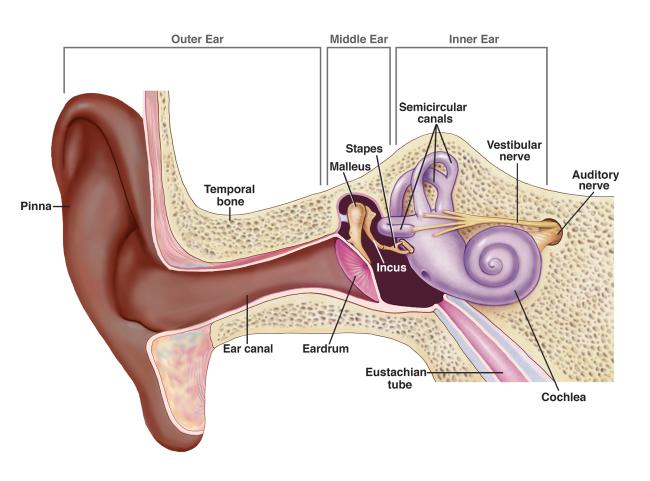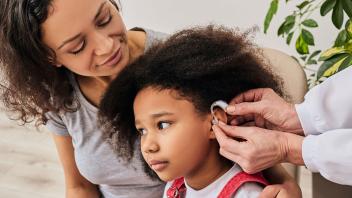Caroline’s story
Caroline is six years old, with bright brown eyes and, at the moment, no front teeth, like so many other first graders. She also wears a hearing aid in each ear’and has done so since she was three, when she was diagnosed with a moderate hearing loss.
For Caroline’s parents, there were many clues along the way. Caroline often didn’t respond to her name if her back was turned. She didn’t startle at noises that made other people jump. She liked the TV on loud. But it was the preschool she started attending when she was three that first put the clues together and suggested to Caroline’s parents that they have her hearing checked. The most significant clue to the preschool was Caroline’s unclear speech, especially the lack of consonants like “d” and “t” at the end of words.
So Caroline’s parents took her to an audiologist, who collected a full medical history, examined the little girl’s ears inside and out, ran a battery of hearing tests and other assessments, and eventually diagnosed that Caroline’s inner ear (the cochlea) was damaged. The audiologist said she had sensorineural hearing loss.
Caroline was immediately fitted with hearing aids. She also began receiving special education and related services through the public school system. Now in the first grade, she regularly gets speech therapy and other services, and her speech has improved dramatically. So has her vocabulary and her attentiveness. She sits in the front row in class, an accommodation that helps her hear the teacher clearly. She’s back on track, soaking up new information like a sponge, and eager for more.
About hearing loss in children
Hearing is one of our five senses. Hearing gives us access to sounds in the world around us’people’s voices, their words, a car horn blown in warning or as hello!
When a child has a hearing loss, it is cause for immediate attention. That’s because language and communication skills develop most rapidly in childhood, especially before the age of 3. When hearing loss goes undetected, children are delayed in developing these skills.
Recognizing the importance of early detection, the Centers for Disease Control and Prevention (the CDC) recommends that every newborn be screened for hearing loss as early as possible, usually before they leave the hospital. Catching a hearing loss early means that treatment can start early as well and “help the child develop communication and language skills that will last a lifetime.”
Types of hearing loss
Before we describe the types of hearing loss a person may have, it’s useful to know that sound is measured by:
- its loudness or intensity (measured in units called decibels, dB); and
- its frequency or pitch (measured in units called hertz, Hz).
Hearing loss is generally described as slight, mild, moderate, severe, or profound, depending upon how well a person can hear the intensities or frequencies most strongly associated with speech. Impairments in hearing can occur in either or both areas, and may exist in only one ear or in both ears. Generally, only children whose hearing loss is greater than 90 decibels (dB) are considered deaf.

There are four types of hearing loss, as follows:
- Conductive hearing losses are caused by diseases or obstructions in the outer or middle ear (the pathways for sound to reach the inner ear). Conductive hearing losses usually affect all frequencies of hearing evenly and do not result in severe losses. A person with a conductive hearing loss usually is able to use a hearing aid well or can be helped medically or surgically.
- Sensorineural hearing losses result from damage to the delicate sensory hair cells of the inner ear or the nerves that supply it. These hearing losses can range from mild to profound. They often affect the person’s ability to hear certain frequencies more than others. Thus, even with amplification to increase the sound level, a person with a sensorineural hearing loss may perceive distorted sounds, sometimes making the successful use of a hearing aid impossible.
- A mixed hearing loss refers to a combination of conductive and sensorineural loss and means that a problem occurs in both the outer or middle and the inner ear.
- A central hearing loss results from damage or impairment to the nerves or nuclei of the central nervous system, either in the pathways to the brain or in the brain itself.
How common is hearing loss?
Each year in the United States, more than 12,000 babies are born with a hearing loss; often, the cause is unknown).
Profound deafness occurs in 4-11 per 10,000 children; in at least 50% of these cases, the cause is genetic).
Through the Universal Newborn Hearing Screening program, many states now mandate that all newborns be screened for hearing loss within hours of birth National Center for Hearing Assessment & Management .
Signs of a hearing loss or deafness
Just as with Caroline, our first grader, there will be signs that a child may not be hearing normally. Parents may notice that their child:
- does not respond consistently to sounds or to his or her own name;
- asks for things to be repeated or often says “huh?”
- is delayed in developing speech or has unclear speech;
- turns the volume up loud on the TV and other electronic devices.
Causes of hearing loss and deafness
Hearing loss and deafness can be either:
- acquired, meaning that the loss occurred after birth, due to illness or injury; or
- congenital, meaning that the hearing loss or deafness was present at birth.
The most common cause of acquired hearing loss is exposure to noise. Other causes can include:
- build up of fluid behind the eardrum;
- ear infections (known as otitis media);
- childhood diseases, such as mumps, measles, or chicken pox; and
- head trauma.
Congenital causes of hearing loss and deafness include:
- a family history of hearing loss or deafness;
- infections during pregnancy (such as rubella);
- complications during pregnancy (such as the Rh factor, maternal diabetes, or toxicity).
A child’s hearing loss or deafness may also be a characteristic of another disability such as Down syndrome, Usher syndrome, Treacher Collins syndrome, Crouzon syndrome, and Alport syndrome.
In all cases, early detection and treatment are very important to the child’s development.
Is there help available?
Yes, there’s a lot of help available, beginning with the free evaluation of the child. The nation’s special education law, the Individuals with Disabilities Education Act (IDEA), requires that all children suspected of having a disability be evaluated without cost to their parents to determine if they do have a disability and, because of the disability, need special services under IDEA. Those special
services are:
- Early intervention | A system of services to support infants and toddlers with disabilities (before their 3rd birthday) and their families.
- Special education and related services | Services available through the public school system for school-aged children, including preschoolers (ages 3-21).
To access early intervention: To identify the EI program in your neighborhood, consult state-specific Information for your state. Early intervention is listed under the first section, State Agencies. The agency that’s identified will be able to put you in contact with the early intervention program in your community. There, you can have your child evaluated free of charge and, if found eligible, your child can begin receiving early intervention services.
To access special education and related services: We recommend that you get in touch with your local public school system. Calling the elementary school in your neighborhood is an excellent place to start. The school should be able to tell you the next steps to having your child evaluated free of charge and, if found eligible, he or she can begin receiving services specially designed to address your child’s needs.
There are also special services available to low-income children through the Early Periodic Screening, Diagnosis, and Treatment (EPSDT) program, the child health component of Medicaid. To learn more about the EPSDT program, visit the EPSDT website .
The U.S. Department of Education reports that 14,787 children received audiology services in early intervention programs in the fall of 2004, while 139,643 children received speech-language pathology services.
The Department also reports that, during the 2003 school year, 79,522 students aged 3 to 21 received special education services under the category of “hearing impairment.” However, the number of children with hearing loss and deafness is undoubtedly higher, since many of these students have other disabilities and may be served under other categories.
Educational implications
Hearing loss or deafness does not affect a person’s intellectual capacity or ability to learn. However, children who are hard of hearing or deaf generally require some form of special education services in order to receive an adequate education. Such services may include:
- regular speech, language, and auditory training from a specialist;
- amplification systems;
- services of an interpreter for those students who use sign language;
- favorable seating in the class to facilitate lip reading;
- captioned films/videos;
- assistance of a notetaker, who takes notes for the student with a hearing loss, so that the student can fully attend to instruction;
- instruction for the teacher and peers in alternate communication methods, such as sign language; and
- counseling.
Children who are hard of hearing will find it much more difficult than children who have normal hearing to learn vocabulary, grammar, word order, idiomatic expressions, and other aspects of verbal communication. For children who are deaf or have severe hearing losses, early, consistent, and conscious use of visible communication modes (such as sign language, fingerspelling, and Cued Speech) and/or amplification and aural/oral training can help reduce this language delay. By age four or five, most children who are deaf are enrolled in school on a full-day basis and do special work on communication and language development.
It is important for teachers and audiologists to work together to teach the child to use his or her residual hearing to the maximum extent possible, even if the preferred means of communication is manual. Since the great majority of deaf children (over 90%) are born to hearing parents, programs should provide instruction for parents on implications of deafness within the family.
People with hearing loss use oral or manual means of communication or a combination of the two. Oral communication includes speech, lip reading, and the use of residual hearing. Manual communication involves signs and fingerspelling. Total Communication, as a method of instruction, is a combination of the oral method plus signing and fingerspelling.
Using the relay service
Individuals with hearing loss, including those who are deaf, now have many helpful devices available to them. Text telephones (known as TTs, TTYs, or TDDs) enable persons to type phone messages over the telephone network.
The Telecommunications Relay Service (TRS) makes it possible for TT users to communicate with virtually anyone (and vice versa) via telephone through a communications assistant. Dial 711 to access all telecommunications relay services anywhere in the United States. The relay service is free.
